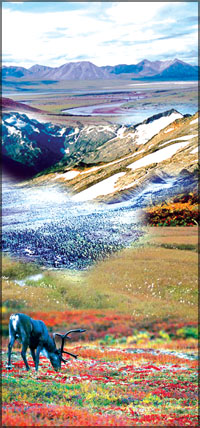The coldest biome
 Tundra
is the coldest of all biomes. Do you know how it got this name? Tundra
comes from the Finnish word tunturi, which means the treeless plain.
This biome is noted for its frost-moulded landscapes, extremely low
temperatures, little precipitation, poor nutrients and short growing
tree seasons. Tundra
is the coldest of all biomes. Do you know how it got this name? Tundra
comes from the Finnish word tunturi, which means the treeless plain.
This biome is noted for its frost-moulded landscapes, extremely low
temperatures, little precipitation, poor nutrients and short growing
tree seasons.
Dead organic material functions as a nutrient pool. The two major
nutrients are nitrogen and phosphorus. The tundra is the simplest biome
in terms of species composition and food chains. The vegetation in this
biome include lichens, mosses, sedges (grass-line plants), perennial
forbs and dwarfed shrubs.
The climate here is the same as for any area with high latitude
conditions; and its impacts on life in this biome include extremely
short cultivation season (6 to 10 weeks) and long, cold and dark winters
(6 to 10 months with average monthly temperatures below 0 degrees
celsius).
Extremely low precipitation (rain or snow), which is less than five
inches per year, is coupled with strong, drying winds. Snowfall is
actually advantageous to the local ecosystem as it provides an
insulating layer on the ground surface. A layer of permafrost
(permanently frozen subsoil in the Arctic region) lies underneath the
ground and prevents any large plants from surviving.
prevents any large plants from surviving.
Because water in the tundra biome is unavailable for most of the year
due to permafrost, the biogeochemical cycles there are somewhat
different than in other biomes.
The water cycle, most obviously, is unusual; water is only available
during the brief Arctic summers, when it sits on frozen ground, making
the surface of the tundra become wet and spongy.
There are two types of tundra biomes in the world; Arctic tundra and
Alpine tundra. The Arctic tundra is located in the northern hemisphere,
encircling the North Pole and extending south to the coniferous forest
(a forest with trees in cone shapes) of the Taiga.
The Arctic is known for its cold, desert-like conditions. The growing
season ranges from 50 to 60 days. The average winter temperature is - 34
degrees Celsius, but the average summer temperature is 3-12 degrees
Celsius, which enables this biome to sustain life.
Rainfall may vary in different regions of the Arctic. Yearly
precipitation, including melting snow, is 15 to 25 cm. Soil is formed
slowly. A layer of permafrost, consisting mostly of gravel and fine
material, exists. When water saturates (fully absorbs) the upper
surface, bogs and ponds may form, providing moisture for plants.
There are no deep root systems in the vegetation of the Arctic
tundra; however, there are still a wide variety of plants that are able
to resist the cold climate. There are about 1,700 kinds of plants in the
Arctic and Subarctic and these include low shrubs, grasses and 400
varieties of flowers.
All of the plants are adapted to sweeping winds and disturbances of
the soil. Plants are short and grow together to resist the cold
temperatures and to be protected by the snow during the winter. They can
carry out photosynthesis at low temperatures and low light intensities.
Animals are adapted to handle long, cold, winter and to breed and
raise their young, in the summer. Animals such as mammals and birds also
have additional insulation from layers of fat.
Many animals hibernate (long sleep) during the winter because food is
not abundant. Another alternative is to migrate south in the winter,
like birds do. Reptiles and amphibians are few or absent because of the
extremely cold temperatures. Because of constant immigration and
emigration, the population continually changes.
Alpine tundra is located on mountains throughout the world at high
altitude where trees cannot grow. The growing season is 180 days. The
night-time temperature is usually below freezing point. Unlike the
Arctic tundra, the soil in the Alpine is well drained.
The plants are very similar to those of the Arctic.
Compiled by Janani Amarasekara |
